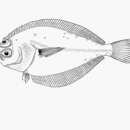en
names in breadcrumbs


Citharichthys gordae, the mimic sanddab, is a species of sanddab in the large-tooth flounder family Paralichthyidae. It is native to the eastern Pacific Ocean, found off the coast of Mexico. It has a limited distribution, found in the Magdalena Bay and along the Baja California peninsula, as well as part of the Gulf of California.
It is a demersal fish that lives in sandy or muddy bottoms of tropical waters, at depths of between 73 and 146 metres (240 and 479 ft). Like the rest of the large-tooth flounders, the mimic sanddab has both eyes on the left side of its head. It grows to a maximum length of around 14 centimetres (5.5 in). It is a brownish color, mottled with darker patches.
Citharichthys gordae, the mimic sanddab, is a species of sanddab in the large-tooth flounder family Paralichthyidae. It is native to the eastern Pacific Ocean, found off the coast of Mexico. It has a limited distribution, found in the Magdalena Bay and along the Baja California peninsula, as well as part of the Gulf of California.
It is a demersal fish that lives in sandy or muddy bottoms of tropical waters, at depths of between 73 and 146 metres (240 and 479 ft). Like the rest of the large-tooth flounders, the mimic sanddab has both eyes on the left side of its head. It grows to a maximum length of around 14 centimetres (5.5 in). It is a brownish color, mottled with darker patches.